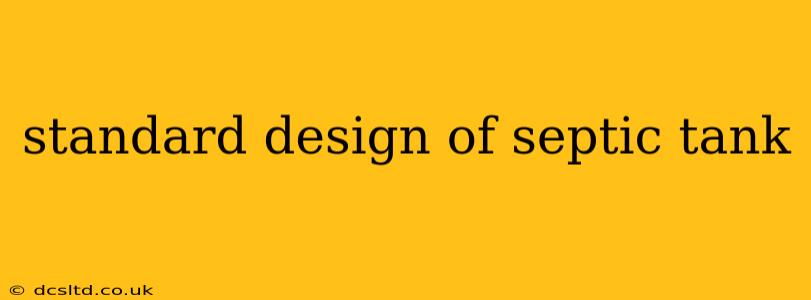Septic tanks are crucial components of on-site wastewater treatment systems, silently working to process household wastewater before it's released into the environment. Understanding their standard design is key to ensuring efficient and environmentally responsible operation. This guide explores the typical features and considerations involved in septic tank design.
What are the standard dimensions of a septic tank?
Septic tank dimensions vary depending on household size and wastewater production. There's no single "standard" size, but typical capacities range from 750 gallons to 1500 gallons for a family of four. Larger families or households with higher water usage require larger tanks. Local building codes and regulations often dictate minimum size requirements. These codes consider factors like the number of bedrooms, anticipated water usage, and soil conditions. Always check your local regulations before installing a septic system.
What are the typical components of a septic tank?
A standard septic tank comprises several key components working in concert:
-
Tank Body: Usually made of concrete, fiberglass, or polyethylene, the tank's body provides a sealed environment for wastewater processing. Concrete tanks are durable but heavier and more prone to cracking if not properly installed. Fiberglass and polyethylene tanks are lighter and more resistant to cracking but may be less durable in the long term.
-
Inlet and Outlet Baffles: These internal structures control the flow of wastewater into and out of the tank, ensuring a slow, even distribution to maximize settling and anaerobic digestion. The baffles prevent solids from being immediately flushed into the drain field.
-
Effluent Filter (Optional but Recommended): An effluent filter located at the outlet removes solids and grease before the wastewater enters the drain field. This is a crucial component for preventing clogs and extending the life of the drain field.
-
Scum and Sludge Layers: During the wastewater treatment process, lighter materials (grease, oil) rise to the top, forming a scum layer, while heavier solids settle at the bottom to form a sludge layer. Regular pumping is necessary to remove accumulated scum and sludge to prevent overflow and maintain efficient operation.
-
Access Ports: These are critical for inspection, maintenance, and pumping. Typically, there are two access ports, one for scum removal and another for sludge removal.
How often should a septic tank be pumped?
This depends on several factors, including tank size, household size, and wastewater generation habits. A general guideline is to have your septic tank pumped every 3-5 years. However, it’s best to have it inspected annually. Signs you might need pumping sooner include slow drains, gurgling sounds from drains, sewage backups, or foul odors.
What are the common problems with septic tanks?
Several issues can affect septic tank performance:
-
Clogging: This can be due to the accumulation of solids, grease buildup, or inappropriate disposal of materials down the drain.
-
Leaks: Cracks in the tank body can lead to leakage, contaminating soil and groundwater.
-
Improper Installation: Incorrect installation can result in ineffective treatment and environmental problems.
-
Insufficient Capacity: A tank that is too small for the household size will quickly overflow.
-
Drain Field Failure: The drain field (where treated wastewater is finally discharged) can fail due to clogging or compaction.
What are the regulations for septic tank installation and maintenance?
Septic tank installation and maintenance are usually governed by local health departments and building codes. Regulations often cover tank size, placement, construction materials, and maintenance schedules. Always consult your local authorities before installing or modifying a septic system to ensure compliance.
What materials are septic tanks made of?
Septic tanks are commonly constructed from concrete, fiberglass, or polyethylene. Each material offers unique advantages and disadvantages. Concrete is durable but heavy and susceptible to cracking if poorly installed or subjected to ground movement. Fiberglass and polyethylene tanks are lighter and more resistant to cracking but may be less durable in the long term. The choice of material depends on factors such as soil conditions, local climate, and budget.
This comprehensive guide provides a solid foundation for understanding standard septic tank design. Remember that local codes and regulations should always guide the design and installation process. For any specific questions regarding your septic system, it's best to consult with a qualified septic system professional.
